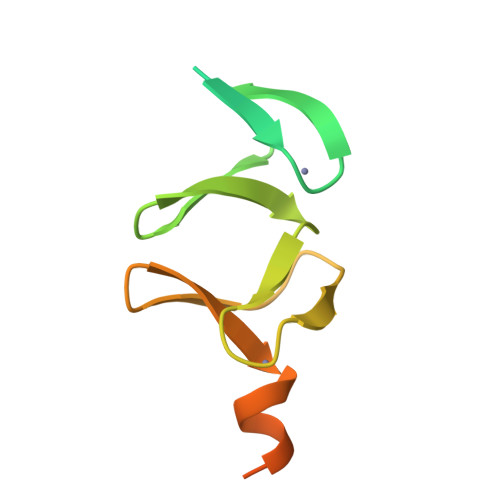Solution structure of the carboxyl-terminal LIM domain from quail cysteine-rich protein CRP2.
Konrat, R., Weiskirchen, R., Krautler, B., Bister, K.(1997) J Biological Chem 272: 12001-12007
- PubMed: 9115265
- DOI: https://doi.org/10.1074/jbc.272.18.12001
- Primary Citation of Related Structures:
1QLI - PubMed Abstract:
Proteins of the cysteine-rich protein (CRP) family (CRP1, CRP2, and CRP3) are implicated in diverse processes linked to cellular differentiation and growth control. CRP proteins contain two LIM domains, each formed by two zinc-binding modules of the CCHC and CCCC type, respectively. The solution structure of the carboxyl-terminal LIM domain (LIM2) from recombinant quail CRP2 was determined by multidimensional homo- and heteronuclear magnetic resonance spectroscopy. The folding topology retains both independent zinc binding modules (CCHC and CCCC). Each module consists of two orthogonally arranged antiparallel beta-sheets, and the carboxyl-terminal CCCC module is terminated by an alpha-helix. 15N magnetic relaxation data indicate that the modules differ in terms of conformational flexibility. They pack together via a hydrophobic core region. In addition, Arg122 in the CCHC module and Glu155 in the CCCC module are linked by an intermodular hydrogen bond and/or salt bridge. These residues are absolutely conserved in the CRP family of LIM proteins, and their interaction might contribute to the relative orientation of the two zinc-binding modules in CRP LIM2 domains. The global fold of quail CRP2 LIM2 is very similar to that of the carboxyl-terminal LIM domain of the related but functionally distinct CRP family member CRP1, analyzed recently. The carboxyl-terminal CCCC module is structurally related to the DNA-binding domain of the erythroid transcription factor GATA-1. In the two zinc-binding modules of quail CRP2 LIM2, flexible loop regions made up of conserved amino acid residues are located on the same side of the LIM2 domain and may cooperate in macromolecular recognition.
Organizational Affiliation:
Institute of Organic Chemistry, University of Innsbruck, A-6020 Innsbruck, Austria. robert.konrat@uibk.ac.at

















